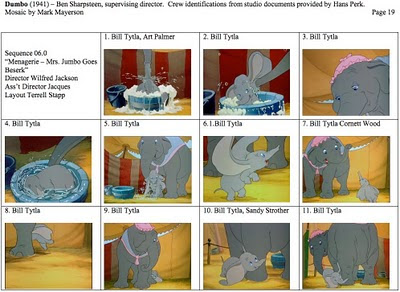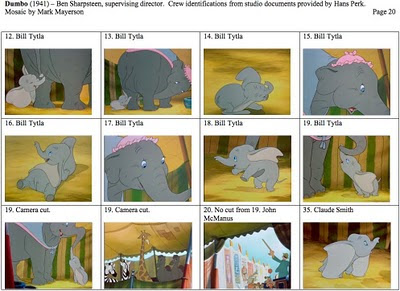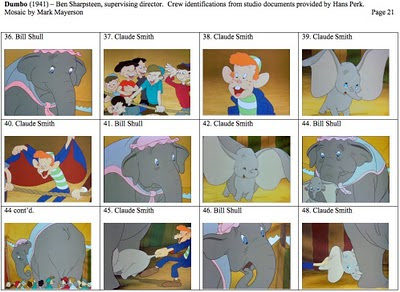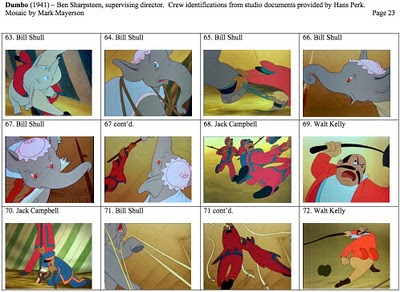




 Once again, the principle of contrast is front and center here. The first half of the sequence is relaxed and heartwarming while the later half is tense and frightening.
Once again, the principle of contrast is front and center here. The first half of the sequence is relaxed and heartwarming while the later half is tense and frightening.The bath section is really a musical sequence, though there are no lyrics. The animation has been tied tightly to the beat and melody of the music. Certainly that was a specialty of sequence director Wilfred Jackson. Animator Bill Tytla, himself the parent of a young son at the time, perfectly captures how a parent and child tease each other and play games, both secure in their loving relationship.
One thing that makes their relationship obvious to the audience is the use of touch. Touch is a powerful way of communicating in life and on film. A caress, a pat on the back or a punch in the nose all communicate clearly. Mrs. Jumbo's trunk is there to wash her child, lift her child or caress it. Dumbo pulls on his mother's tail. The willing physical connection between the two makes their feelings for each other plain.
This sequence is crucial for making the film work emotionally. By showing how supportive Mrs. Jumbo is of her child and how happy Dumbo is in her presence, the audience feels the injustice and pain of their separation all the more.
Touch is also a major element in the latter half. Skinnay (as he is named in the draft) thinks nothing of grabbing Dumbo's ear or tail. Mrs. Jumbo understandably tries to remove her child to safety, but Skinnay won't take the hint and ends up being spanked by Mrs. Jumbo. The loving touch of the bath has given way to the aggressive touches of ridicule and revenge.
The ringmaster then uses the stinging touch of the whip and the roustabouts use the constraining touch of ropes and chains to subdue Mrs. Jumbo.
Touch isn't used as often as it should be in animation due to technical issues. A single character is the easiest to animate. Two characters sharing the screen require more planning so that their timing is complementary and the audience knows which character to look at. Generally, two characters who aren't physically interacting would be done on separate levels of paper, giving the animator the maximum freedom to alter their timings. However, whenever characters touch, either they are animated on a single level or their timing must be coordinated even more closely. That's extra work. In cgi, the animator doesn't have to worry about levels when characters touch, but does have to worry about intersections instead.
Once the ringmaster shows up, there are some striking low angle layouts to emphasize Mrs. Jumbo's size compared to the roustabouts. (And I was wrong, writing in part 5 that the roustabouts disappear from the film after raising the tent; clearly these roustabouts are also black.)
The quality of drawing suffers somewhat in the latter half of this sequence. The mob of children are pretty rough. The ringmaster and roustabouts are also not very well refined. There's a painting mistake in shot 57; the ringmaster has no white in his eyes. It's true that with fast cutting and fast action, detail matters less, but I see this as more evidence of the low budget having an effect on what's on screen. Certainly, you don't see work this rough in Fantasia.
Bill Shull does an excellent job on Mrs. Jumbo during the struggle. She's the emotional focus at this point, so it's important that she be drawn and animated well to maintain our sympathy. Note that her eyes turn red in shot 66 after Dumbo is taken away and she is chained. It's a small touch that does a nice job of stressing her increasing agitation. Prior to this, she has tried to protect Dumbo and to resist being confined. After this, she gets aggressive, tossing a roustabout into a crowd of others and dunking the ringmaster in Dumbo's washtub.
(I should point out that Michael Sporn has been featuring a lot of Dumbo pre-production artwork. Here are two segments (one and two) on the roustabouts. Here is a segment devoted to the bath sequence. Here is the "Baby Mine" sequence. Here are two sections on "Pink Elephants" (one and two) and finally, here are some random storyboards and a collection of model sheets.)



4 comments:
The second half of this sequence is very uncharacteristic of Jaxon. It's very fast, and it seems unorgaznized. I find its very hard to believe that THIS, AND "Song of the south" were from the same person.
Is it just me, or do the characters feel a lot less human when the second stringers take over? I mean, shot 46 is amazingly expressive, but thats about it.
"Is it just me, or do the characters feel a lot less human when the second stringers take over? I mean, shot 46 is amazingly expressive, but thats about it."
I like it. I find it a good use of caricature and exaggeration to show the inhumanity of the act Skinny is doing.
Great post Mr. Mayerson. This whole sequence is wonderful. It does so well in displaying the emotions and clearly exhibiting the relationship between Mrs. Jumbo and her little boy. It still touches my heart. Even from these individual shots, I feel the power and the emotion of the scene. That shows truly great filmmaking.
Bill Shull seems to have worked very closely with Bill Tytla, as he used to be his assistant.
The Dumbo theme is composed by Oliver Wallace who co-scored the film with Frank Churchill. Wallace also wrote the music for "When I See An Elephant Fly". He also scored many of the later Disney shorts.
Post a Comment